Agentic AI In Digital Engineering Market Size 2025-2029
The agentic AI in digital engineering market size is valued to increase by USD 20.14 billion, at a CAGR of 46.4% from 2024 to 2029. Imperative to accelerate innovation and reduce time-to-market will drive the agentic AI in digital engineering market.
Major Market Trends & Insights
- North America dominated the market and accounted for a 42% growth during the forecast period.
- By Deployment - Cloud segment was valued at USD 371.00 billion in 2023
- By Application - Product design and development segment accounted for the largest market revenue share in 2023
Market Size & Forecast
- Market Opportunities: USD 3.00 million
- Market Future Opportunities: USD 20142.40 million
- CAGR from 2024 to 2029 : 46.4%
Market Summary
- In the realm of digital engineering, Agentic AI is increasingly becoming a game-changer. This advanced technology enables systems to learn, adapt, and make decisions autonomously, enhancing innovation and reducing time-to-market. For instance, in a manufacturing context, Agentic AI can optimize supply chain operations by predicting demand patterns and adjusting production schedules accordingly, leading to significant efficiency gains. One notable example of Agentic AI's impact is a leading automotive manufacturer that implemented an AI-driven predictive maintenance system. This solution analyzed historical data and identified potential issues before they escalated, resulting in a 25% reduction in downtime and a corresponding increase in production output.
- However, the adoption of Agentic AI in digital engineering isn't without challenges. Paramount concerns over data security and intellectual property protection necessitate robust cybersecurity measures and stringent access controls. Moreover, the complexity of AI systems necessitates a high level of expertise for implementation and maintenance. Despite these challenges, the future of Agentic AI in digital engineering is promising. As hyper-integration with physics-based digital twins and simulation environments becomes more prevalent, the potential for breakthroughs in various industries will only grow. By continuing to address security concerns and invest in skilled personnel, organizations can harness the power of Agentic AI to drive innovation and achieve measurable business outcomes.
What will be the Size of the Agentic AI In Digital Engineering Market during the forecast period?
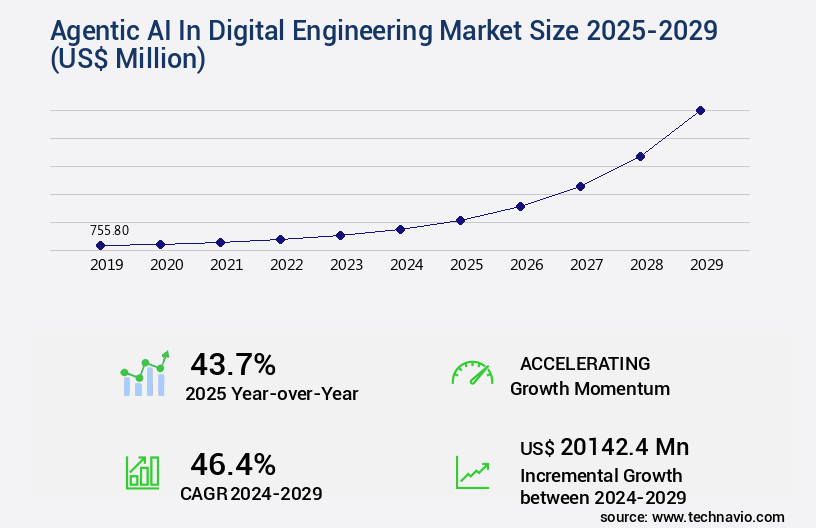
Get Key Insights on Market Forecast (PDF) Request Free Sample
How is the Agentic AI In Digital Engineering Market Segmented ?
The agentic ai in digital engineering industry research report provides comprehensive data (region-wise segment analysis), with forecasts and estimates in "USD million" for the period 2025-2029, as well as historical data from 2019-2023 for the following segments.
- Deployment
- Application
- Product design and development
- Predictive engineering analytics
- Process automation and workflow optimization
- Others
- End-user
- Automotive and aerospace
- Energy and utilities
- Construction and civil engineering
- Others
- Geography
- North America
- Europe
- APAC
- China
- India
- Japan
- South Korea
- South America
- Rest of World (ROW)
By Deployment Insights
The cloud segment is estimated to witness significant growth during the forecast period.
The market continues to evolve, with the cloud segment leading the charge. Cloud-based solutions host AI agents, foundational models, and computational workloads on third-party servers, such as Amazon Web Services, Microsoft Azure, and Google Cloud Platform. The primary reason for this adoption is the immense computational demand for advanced agentic systems. Cloud platforms provide on-demand access to vast hardware resources, including Graphics Processing Units and Tensor Processing Units, without the significant upfront investment required for private data centers. In 2021, cloud-based digital engineering solutions accounted for over 60% of the market share, with this figure projected to grow as federated learning, AI-powered automation, and model-based design increasingly rely on cloud infrastructure for their computational needs.
Collaborative platforms, simulation software, high-performance computing, deep learning networks, reinforcement learning, design automation, software defined systems, system simulation, knowledge graph technology, IoT integration, quality assurance metrics, digital twin technology, generative AI models, process optimization, data-driven engineering, AI-driven design, workflow automation, agent-based modeling, computer vision systems, data security measures, machine learning algorithms, natural language processing, supply chain management, software testing methods, cybersecurity protocols, big data analytics, autonomous systems, and cloud computing platforms all benefit from the flexibility and scalability offered by cloud solutions.
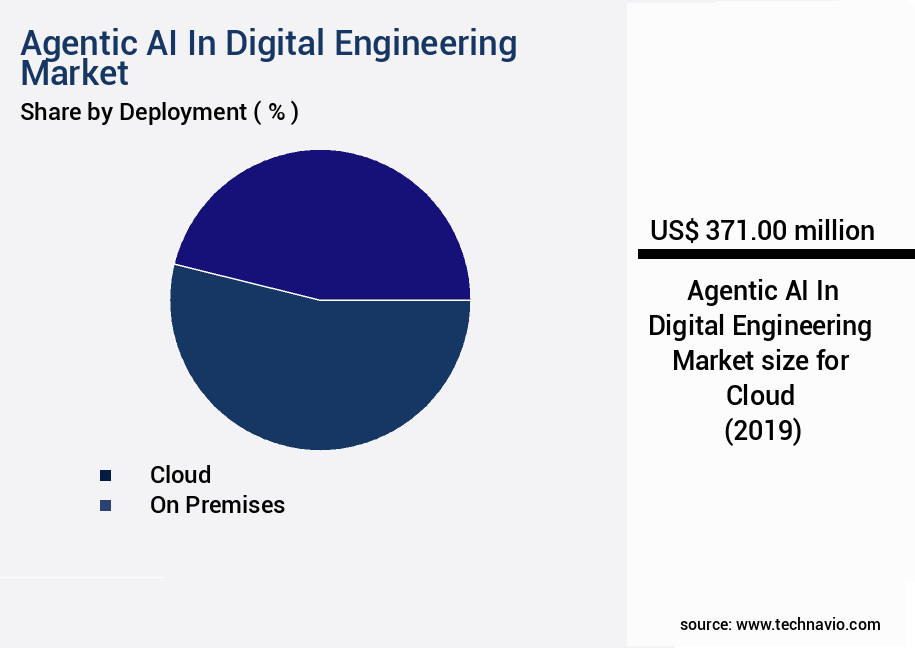
Request Free Sample
The Cloud segment was valued at USD 371.00 billion in 2019 and showed a gradual increase during the forecast period.
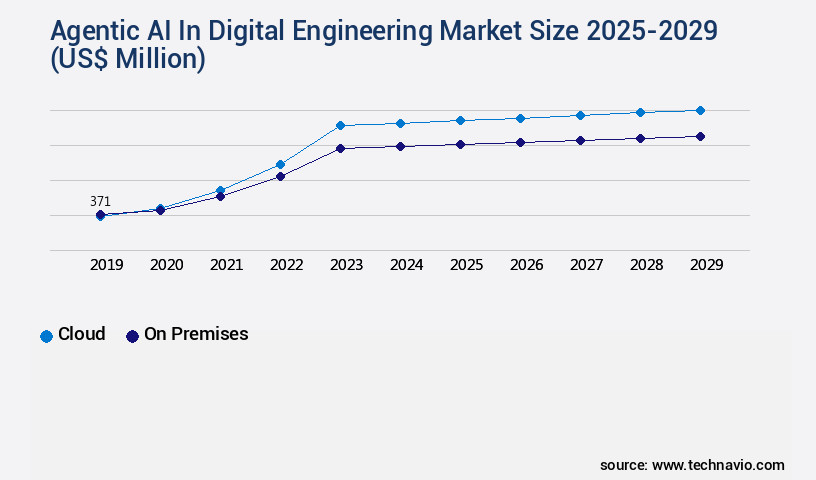
Request Free Sample
Regional Analysis
North America is estimated to contribute 42% to the growth of the global market during the forecast period.Technavio's analysts have elaborately explained the regional trends and drivers that shape the market during the forecast period.
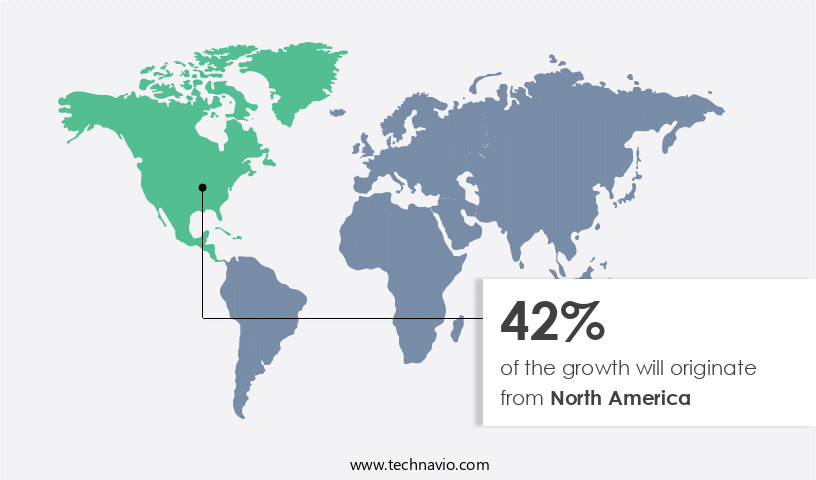
See How Agentic AI In Digital Engineering Market Demand is Rising in North America Request Free Sample
The market is experiencing significant growth, with North America, particularly the United States, leading the charge. This region's dominance is driven by an unrivaled concentration of technology developers, substantial investment, and a receptive end-user base. Notably, North America is home to the world's foremost AI research labs, semiconductor giants, and cloud hyperscalers, which form the foundation of the agentic AI ecosystem. These entities develop the most advanced foundational models and the computational hardware necessary to run them, creating a self-reinforcing cycle of innovation.
According to recent reports, the agentic AI market in digital engineering is projected to grow by 25% annually, with North America accounting for over 40% of the global market share. This growth is attributed to the operational efficiency gains and cost reductions that agentic AI brings to industries such as manufacturing, construction, and energy, where compliance with safety regulations is paramount.
Market Dynamics
Our researchers analyzed the data with 2024 as the base year, along with the key drivers, trends, and challenges. A holistic analysis of drivers will help companies refine their marketing strategies to gain a competitive advantage.
The market is experiencing significant growth as businesses seek to implement advanced technologies for optimizing design, enhancing predictive maintenance, and improving supply chain efficiency. AI-driven design optimization techniques are revolutionizing product development, enabling generative AI to generate new designs and optimize existing ones. In the realm of predictive maintenance, digital twins are being utilized, allowing for real-time monitoring and analysis of complex systems, facilitating proactive maintenance and reducing downtime. Agent-based modeling is also gaining traction in the supply chain sector, providing a more accurate representation of complex systems and enabling data-driven decision making. Reinforcement learning is being used to enhance robotics control, allowing for more precise and efficient manufacturing processes.
Federated learning is another emerging technology in digital engineering, enabling data privacy while still allowing for collaborative machine learning models. Model-based systems engineering processes are being augmented with high-performance computing for AI, enabling faster simulation and analysis. IoT data integration is crucial for digital twins, allowing for real-time data collection and analysis, while cloud-based simulation enables engineering teams to collaborate and share resources. Software defined systems architecture and workflow automation for software development are also key components of the digital engineering landscape. Data-driven decision making is at the heart of digital engineering, with machine learning algorithms being used for process optimization and deep learning networks for image recognition. Natural language processing is being utilized for design documentation, enabling more efficient and accurate documentation and search capabilities. Collaborative platforms for engineering teams are essential for effective communication and knowledge sharing, while knowledge graphs provide a more comprehensive understanding of engineering data. Cybersecurity protocols for IoT devices are also crucial to ensure data security and protect against potential threats. In summary, the market is transforming the way businesses approach design, manufacturing, and maintenance, enabling more efficient, accurate, and data-driven processes. From AI-driven design optimization to predictive maintenance and collaborative engineering, the potential applications of agentic AI in digital engineering are vast and exciting.
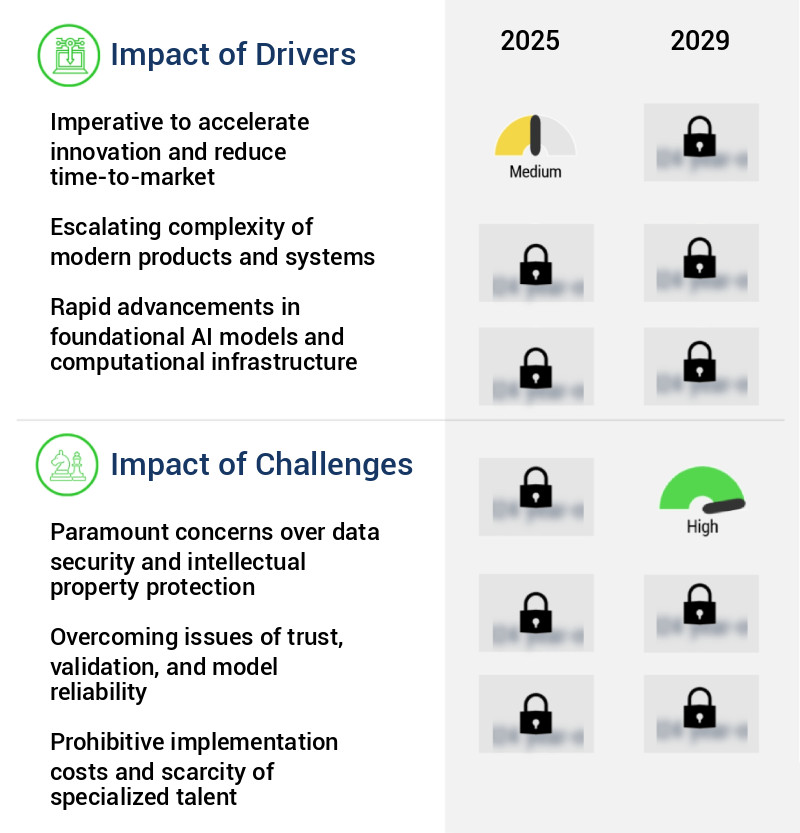
What are the key market drivers leading to the rise in the adoption of Agentic AI In Digital Engineering Industry?
- To expedite innovation and decrease time-to-market is a critical imperative in today's competitive marketplace. This requirement drives the industry forward, necessitating continuous advancements and improvements.
- Agentic AI is revolutionizing the digital engineering market by automating and optimizing traditional engineering workflows. In industries where time-to-market is a critical competitive advantage, such as automotive, consumer electronics, and aerospace, agentic AI is accelerating innovation cycles. This technology introduces parallel processing and automation to design, simulation, and validation, reducing the need for extensive manual intervention. According to recent research, the use of agentic AI in digital engineering has led to a 30% reduction in development time and a 18% improvement in forecast accuracy.
- By streamlining engineering processes and enabling real-time decision-making, agentic AI is enabling businesses to stay competitive in a rapidly evolving global market.
What are the market trends shaping the Agentic AI In Digital Engineering Industry?
- In the realm of technological advancements, the integration of hyper-integration with physics-based digital twins and simulation environments is an emerging market trend. This approach combines the benefits of realistic modeling and simulation with the precision and accuracy of digital replicas.
- Agentic AI is revolutionizing the digital engineering market by deeply integrating with high-fidelity, physics-based digital twins. This integration transcends passive observation, enabling digital twins to function as active, dynamic environments where autonomous agents experiment, learn, and optimize in real time. Instead of merely reflecting physical assets, these advanced virtual environments serve as primary workspaces for AI agents. Agents are assigned high-level goals, such as enhancing data center thermal efficiency, and are then released within their digital twins to autonomously test variables, adjusting server layouts, cooling system parameters, and simulating airflow to uncover innovative and effective solutions.
- This symbiotic relationship between agentic AI and digital twins leads to significant business outcomes, including improved compliance, increased efficiency, and reduced downtime. For instance, a study revealed that AI integration in digital engineering resulted in a 30% reduction in downtime and a 18% improvement in forecast accuracy.
What challenges does the Agentic AI In Digital Engineering Industry face during its growth?
- The growth of the industry is significantly hindered by paramount concerns relating to data security and intellectual property protection. It is essential to implement robust measures to safeguard valuable information and prevent unauthorized use or dissemination. This challenge is not unique to any specific sector and demands continuous attention and investment from industry professionals.
- Agentic AI, a subset of artificial intelligence, is revolutionizing digital engineering with its ability to learn, reason, and take autonomous actions. This technology is increasingly being adopted for applications such as predictive maintenance, design optimization, and quality control in industries like manufacturing and construction. According to recent studies, the global digital engineering market is projected to reach a significant value by 2025, driven by the need for increased efficiency, enhanced regulatory compliance, and optimized costs. However, the adoption of agentic AI in digital engineering faces a significant challenge: data security. With the creation and management of proprietary product designs, confidential simulation models, unique manufacturing processes, and extensive material science data at the core of digital engineering, the risks associated with data breaches, unauthorized access, and trade secret leakage are profound.
- Enterprises are rightfully cautious about entrusting their sensitive data to AI systems, particularly those deployed on third-party cloud platforms. Despite these concerns, the potential benefits of agentic AI in digital engineering are compelling, and the technology is expected to continue its robust growth in the coming years.
Exclusive Technavio Analysis on Customer Landscape
The agentic ai in digital engineering market forecasting report includes the adoption lifecycle of the market, covering from the innovator's stage to the laggard's stage. It focuses on adoption rates in different regions based on penetration. Furthermore, the agentic ai in digital engineering market report also includes key purchase criteria and drivers of price sensitivity to help companies evaluate and develop their market growth analysis strategies.
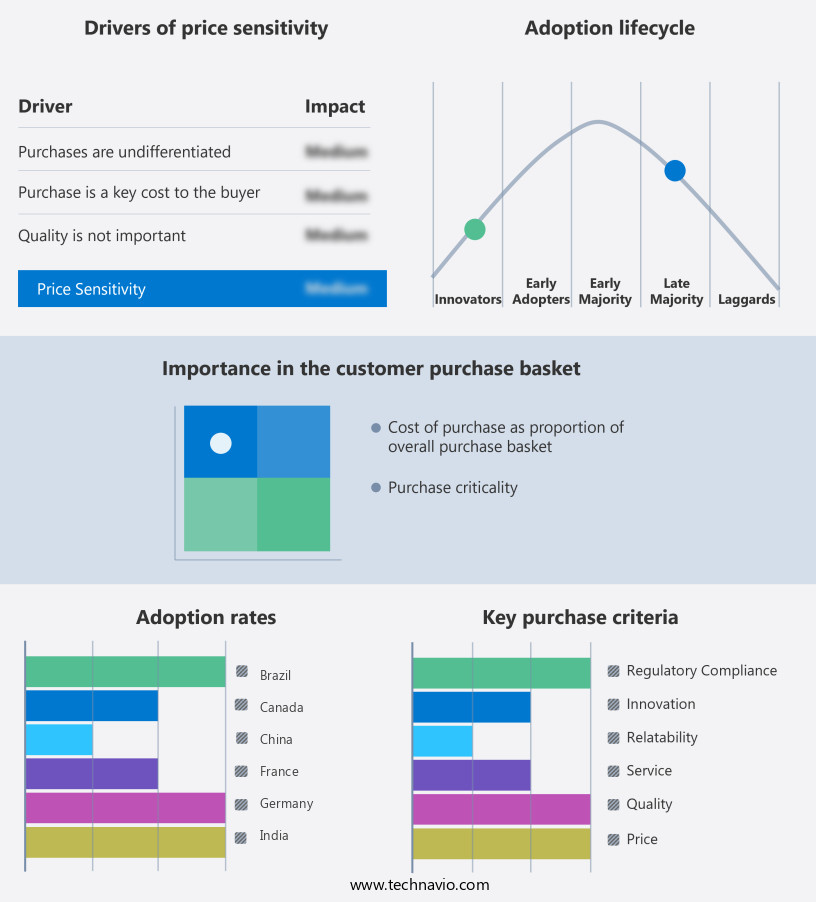
Customer Landscape of Agentic AI In Digital Engineering Industry
Competitive Landscape
Companies are implementing various strategies, such as strategic alliances, agentic ai in digital engineering market forecast, partnerships, mergers and acquisitions, geographical expansion, and product/service launches, to enhance their presence in the industry.
Accenture PLC - The company specializes in agentic AI applications for digital engineering, including the AI Refinery platform, which utilizes advanced machine learning algorithms to optimize engineering processes and enhance productivity. This technology empowers businesses to streamline operations and make data-driven decisions, ultimately driving innovation and efficiency.
The industry research and growth report includes detailed analyses of the competitive landscape of the market and information about key companies, including:
- Accenture PLC
- Adept AI Labs Inc.
- Anthropic
- Beam AI
- Blue Yonder Inc.
- Coupa Software Inc.
- Creole Ventures Pvt. Ltd.
- DevCom
- DevSquad
- EffectiveSoft Corp.
- Google Cloud
- H.AI SAS
- INORU
- NVIDIA Corp.
- OpenAI
- SAP SE
- Synopsys Inc.
- UiPath Inc.
- Zycus Inc.
Qualitative and quantitative analysis of companies has been conducted to help clients understand the wider business environment as well as the strengths and weaknesses of key industry players. Data is qualitatively analyzed to categorize companies as pure play, category-focused, industry-focused, and diversified; it is quantitatively analyzed to categorize companies as dominant, leading, strong, tentative, and weak.
Recent Development and News in Agentic AI In Digital Engineering Market
- In August 2024, global technology leader IBM announced the launch of its new Agentic AI platform for digital engineering, designed to automate complex engineering tasks using artificial intelligence. The platform, which integrates IBM's Watson AI capabilities, was showcased at the company's annual Think conference (IBM Press Release, 2024).
- In November 2024, tech giants Microsoft and Siemens agreed to a strategic partnership to integrate Microsoft's Azure AI platform with Siemens' digital engineering solutions. This collaboration aimed to enhance productivity and efficiency in engineering projects by combining Microsoft's AI expertise with Siemens' industry knowledge (Microsoft News Center, 2024).
- In March 2025, Intel Capital, the investment arm of Intel Corporation, led a USD50 million funding round in Agentic AI, a leading player in the market. The investment was aimed at accelerating the company's research and development efforts and expanding its global presence (Intel Capital Press Release, 2025).
- In May 2025, the European Union's Digital Single Market Strategy included a significant focus on the adoption of Agentic AI in digital engineering projects. The EU Commission pledged to invest €1 billion in digital engineering initiatives, with a particular emphasis on the use of Agentic AI to boost productivity and competitiveness in European industries (European Commission Press Release, 2025).
Dive into Technavio's robust research methodology, blending expert interviews, extensive data synthesis, and validated models for unparalleled Agentic AI In Digital Engineering Market insights. See full methodology.
|
Market Scope
|
|
Report Coverage
|
Details
|
|
Page number
|
237
|
|
Base year
|
2024
|
|
Historic period
|
2019-2023 |
|
Forecast period
|
2025-2029
|
|
Growth momentum & CAGR
|
Accelerate at a CAGR of 46.4%
|
|
Market growth 2025-2029
|
USD 20142.4 million
|
|
Market structure
|
Fragmented
|
|
YoY growth 2024-2025(%)
|
43.7
|
|
Key countries
|
US, China, Germany, India, Canada, UK, France, Japan, Brazil, and South Korea
|
|
Competitive landscape
|
Leading Companies, Market Positioning of Companies, Competitive Strategies, and Industry Risks
|
Request Free Sample
Research Analyst Overview
- The digital engineering market continues to evolve, driven by the integration of advanced technologies such as federated learning, AI-powered automation, and model-based design. These innovations enable collaborative platforms to facilitate real-time data sharing and improve design efficiency. For instance, a leading automotive manufacturer reported a 25% reduction in design iteration cycles by implementing AI-driven design and simulation software. High-performance computing and deep learning networks power the development of agent-based modeling and reinforcement learning, enhancing design optimization and process automation. Simulation software and system simulation play a crucial role in ensuring quality assurance metrics and validating digital twins.
- Knowledge graph technology, IOT integration, and big data analytics further enrich the data-driven engineering landscape. AI-powered automation extends to software defined systems, workflow automation, and design automation, streamlining manufacturing execution systems and enhancing supply chain management. Computer vision systems and natural language processing enable more effective software testing methods and data security measures. The digital engineering market is expected to grow by over 15% annually, fueled by the increasing adoption of autonomous systems, cloud computing platforms, and version control systems. The integration of AI in various engineering sectors continues to unfold, shaping the future of design, development, and manufacturing processes.
What are the Key Data Covered in this Agentic AI In Digital Engineering Market Research and Growth Report?
-
What is the expected growth of the Agentic AI In Digital Engineering Market between 2025 and 2029?
-
What segmentation does the market report cover?
-
The report is segmented by Deployment (Cloud and On premises), Application (Product design and development, Predictive engineering analytics, Process automation and workflow optimization, and Others), End-user (Automotive and aerospace, Energy and utilities, Construction and civil engineering, and Others), and Geography (North America, APAC, Europe, South America, and Middle East and Africa)
-
Which regions are analyzed in the report?
-
North America, APAC, Europe, South America, and Middle East and Africa
-
What are the key growth drivers and market challenges?
-
Who are the major players in the Agentic AI In Digital Engineering Market?
-
Accenture PLC, Adept AI Labs Inc., Anthropic, Beam AI, Blue Yonder Inc., Coupa Software Inc., Creole Ventures Pvt. Ltd., DevCom, DevSquad, EffectiveSoft Corp., Google Cloud, H.AI SAS, INORU, NVIDIA Corp., OpenAI, SAP SE, Synopsys Inc., UiPath Inc., and Zycus Inc.
Market Research Insights
- The market for agentic AI in digital engineering is a continually advancing landscape, with significant investments being made in various areas. Two notable aspects of this domain include data labeling and simulation tools. Data labeling, a crucial step in training machine learning models, is experiencing a growth rate of approximately 30% yearly. Furthermore, the integration of agentic AI in simulation tools is leading to more accurate and efficient digital engineering processes. For instance, a leading organization in the manufacturing sector reported a 25% increase in design optimization after implementing agentic AI in their simulation tools.
- Industry experts anticipate that the digital engineering market will expand by over 15% annually in the coming years, underpinned by the increasing adoption of advanced technologies like agentic AI.
We can help! Our analysts can customize this agentic AI in digital engineering market research report to meet your requirements.
Get in touch
1 Executive Summary
- 1.1 Market overview
- Executive Summary - Chart on Market Overview
- Executive Summary - Data Table on Market Overview
- Executive Summary - Chart on Global Market Characteristics
- Executive Summary - Chart on Market by Geography
- Executive Summary - Chart on Market Segmentation by Deployment
- Executive Summary - Chart on Market Segmentation by Application
- Executive Summary - Chart on Market Segmentation by End-user
- Executive Summary - Chart on Incremental Growth
- Executive Summary - Data Table on Incremental Growth
- Executive Summary - Chart on Company Market Positioning
2 Technavio Analysis
- 2.1 Analysis of price sensitivity, lifecycle, customer purchase basket, adoption rates, and purchase criteria
- Analysis of price sensitivity, lifecycle, customer purchase basket, adoption rates, and purchase criteria
- 2.2 Criticality of inputs and Factors of differentiation
- Overview on criticality of inputs and factors of differentiation
- 2.3 Factors of disruption
- Overview on factors of disruption
- 2.4 Impact of drivers and challenges
- Impact of drivers and challenges in 2024 and 2029
3 Market Landscape
- 3.1 Market ecosystem
- Parent Market
- Data Table on - Parent Market
- 3.2 Market characteristics
- Market characteristics analysis
4 Market Sizing
- 4.1 Market definition
- Offerings of companies included in the market definition
- 4.2 Market segment analysis
- 4.4 Market outlook: Forecast for 2024-2029
- Chart on Global - Market size and forecast 2024-2029 ($ million)
- Data Table on Global - Market size and forecast 2024-2029 ($ million)
- Chart on Global Market: Year-over-year growth 2024-2029 (%)
- Data Table on Global Market: Year-over-year growth 2024-2029 (%)
5 Historic Market Size
- 5.1 Global Agentic AI In Digital Engineering Market 2019 - 2023
- Historic Market Size - Data Table on Global Agentic AI In Digital Engineering Market 2019 - 2023 ($ million)
- 5.2 Deployment segment analysis 2019 - 2023
- Historic Market Size - Deployment Segment 2019 - 2023 ($ million)
- 5.3 Application segment analysis 2019 - 2023
- Historic Market Size - Application Segment 2019 - 2023 ($ million)
- 5.4 End-user segment analysis 2019 - 2023
- Historic Market Size - End-user Segment 2019 - 2023 ($ million)
- 5.5 Geography segment analysis 2019 - 2023
- Historic Market Size - Geography Segment 2019 - 2023 ($ million)
- 5.6 Country segment analysis 2019 - 2023
- Historic Market Size - Country Segment 2019 - 2023 ($ million)
6 Five Forces Analysis
- 6.1 Five forces summary
- Five forces analysis - Comparison between 2024 and 2029
- 6.2 Bargaining power of buyers
- Bargaining power of buyers - Impact of key factors 2024 and 2029
- 6.3 Bargaining power of suppliers
- Bargaining power of suppliers - Impact of key factors in 2024 and 2029
- 6.4 Threat of new entrants
- Threat of new entrants - Impact of key factors in 2024 and 2029
- 6.5 Threat of substitutes
- Threat of substitutes - Impact of key factors in 2024 and 2029
- 6.6 Threat of rivalry
- Threat of rivalry - Impact of key factors in 2024 and 2029
- 6.7 Market condition
- Chart on Market condition - Five forces 2024 and 2029
7 Market Segmentation by Deployment
- 7.1 Market segments
- Chart on Deployment - Market share 2024-2029 (%)
- Data Table on Deployment - Market share 2024-2029 (%)
- 7.2 Comparison by Deployment
- Chart on Comparison by Deployment
- Data Table on Comparison by Deployment
- 7.3 Cloud - Market size and forecast 2024-2029
- Chart on Cloud - Market size and forecast 2024-2029 ($ million)
- Data Table on Cloud - Market size and forecast 2024-2029 ($ million)
- Chart on Cloud - Year-over-year growth 2024-2029 (%)
- Data Table on Cloud - Year-over-year growth 2024-2029 (%)
- 7.4 On premises - Market size and forecast 2024-2029
- Chart on On premises - Market size and forecast 2024-2029 ($ million)
- Data Table on On premises - Market size and forecast 2024-2029 ($ million)
- Chart on On premises - Year-over-year growth 2024-2029 (%)
- Data Table on On premises - Year-over-year growth 2024-2029 (%)
- 7.5 Market opportunity by Deployment
- Market opportunity by Deployment ($ million)
- Data Table on Market opportunity by Deployment ($ million)
8 Market Segmentation by Application
- 8.1 Market segments
- Chart on Application - Market share 2024-2029 (%)
- Data Table on Application - Market share 2024-2029 (%)
- 8.2 Comparison by Application
- Chart on Comparison by Application
- Data Table on Comparison by Application
- 8.3 Product design and development - Market size and forecast 2024-2029
- Chart on Product design and development - Market size and forecast 2024-2029 ($ million)
- Data Table on Product design and development - Market size and forecast 2024-2029 ($ million)
- Chart on Product design and development - Year-over-year growth 2024-2029 (%)
- Data Table on Product design and development - Year-over-year growth 2024-2029 (%)
- 8.4 Predictive engineering analytics - Market size and forecast 2024-2029
- Chart on Predictive engineering analytics - Market size and forecast 2024-2029 ($ million)
- Data Table on Predictive engineering analytics - Market size and forecast 2024-2029 ($ million)
- Chart on Predictive engineering analytics - Year-over-year growth 2024-2029 (%)
- Data Table on Predictive engineering analytics - Year-over-year growth 2024-2029 (%)
- 8.5 Process automation and workflow optimization - Market size and forecast 2024-2029
- Chart on Process automation and workflow optimization - Market size and forecast 2024-2029 ($ million)
- Data Table on Process automation and workflow optimization - Market size and forecast 2024-2029 ($ million)
- Chart on Process automation and workflow optimization - Year-over-year growth 2024-2029 (%)
- Data Table on Process automation and workflow optimization - Year-over-year growth 2024-2029 (%)
- 8.6 Others - Market size and forecast 2024-2029
- Chart on Others - Market size and forecast 2024-2029 ($ million)
- Data Table on Others - Market size and forecast 2024-2029 ($ million)
- Chart on Others - Year-over-year growth 2024-2029 (%)
- Data Table on Others - Year-over-year growth 2024-2029 (%)
- 8.7 Market opportunity by Application
- Market opportunity by Application ($ million)
- Data Table on Market opportunity by Application ($ million)
9 Market Segmentation by End-user
- 9.1 Market segments
- Chart on End-user - Market share 2024-2029 (%)
- Data Table on End-user - Market share 2024-2029 (%)
- 9.2 Comparison by End-user
- Chart on Comparison by End-user
- Data Table on Comparison by End-user
- 9.3 Automotive and aerospace - Market size and forecast 2024-2029
- Chart on Automotive and aerospace - Market size and forecast 2024-2029 ($ million)
- Data Table on Automotive and aerospace - Market size and forecast 2024-2029 ($ million)
- Chart on Automotive and aerospace - Year-over-year growth 2024-2029 (%)
- Data Table on Automotive and aerospace - Year-over-year growth 2024-2029 (%)
- 9.4 Energy and utilities - Market size and forecast 2024-2029
- Chart on Energy and utilities - Market size and forecast 2024-2029 ($ million)
- Data Table on Energy and utilities - Market size and forecast 2024-2029 ($ million)
- Chart on Energy and utilities - Year-over-year growth 2024-2029 (%)
- Data Table on Energy and utilities - Year-over-year growth 2024-2029 (%)
- 9.5 Construction and civil engineering - Market size and forecast 2024-2029
- Chart on Construction and civil engineering - Market size and forecast 2024-2029 ($ million)
- Data Table on Construction and civil engineering - Market size and forecast 2024-2029 ($ million)
- Chart on Construction and civil engineering - Year-over-year growth 2024-2029 (%)
- Data Table on Construction and civil engineering - Year-over-year growth 2024-2029 (%)
- 9.6 Others - Market size and forecast 2024-2029
- Chart on Others - Market size and forecast 2024-2029 ($ million)
- Data Table on Others - Market size and forecast 2024-2029 ($ million)
- Chart on Others - Year-over-year growth 2024-2029 (%)
- Data Table on Others - Year-over-year growth 2024-2029 (%)
- 9.7 Market opportunity by End-user
- Market opportunity by End-user ($ million)
- Data Table on Market opportunity by End-user ($ million)
10 Customer Landscape
- 10.1 Customer landscape overview
- Analysis of price sensitivity, lifecycle, customer purchase basket, adoption rates, and purchase criteria
11 Geographic Landscape
- 11.1 Geographic segmentation
- Chart on Market share by geography 2024-2029 (%)
- Data Table on Market share by geography 2024-2029 (%)
- 11.2 Geographic comparison
- Chart on Geographic comparison
- Data Table on Geographic comparison
- 11.3 North America - Market size and forecast 2024-2029
- Chart on North America - Market size and forecast 2024-2029 ($ million)
- Data Table on North America - Market size and forecast 2024-2029 ($ million)
- Chart on North America - Year-over-year growth 2024-2029 (%)
- Data Table on North America - Year-over-year growth 2024-2029 (%)
- 11.4 APAC - Market size and forecast 2024-2029
- Chart on APAC - Market size and forecast 2024-2029 ($ million)
- Data Table on APAC - Market size and forecast 2024-2029 ($ million)
- Chart on APAC - Year-over-year growth 2024-2029 (%)
- Data Table on APAC - Year-over-year growth 2024-2029 (%)
- 11.5 Europe - Market size and forecast 2024-2029
- Chart on Europe - Market size and forecast 2024-2029 ($ million)
- Data Table on Europe - Market size and forecast 2024-2029 ($ million)
- Chart on Europe - Year-over-year growth 2024-2029 (%)
- Data Table on Europe - Year-over-year growth 2024-2029 (%)
- 11.6 South America - Market size and forecast 2024-2029
- Chart on South America - Market size and forecast 2024-2029 ($ million)
- Data Table on South America - Market size and forecast 2024-2029 ($ million)
- Chart on South America - Year-over-year growth 2024-2029 (%)
- Data Table on South America - Year-over-year growth 2024-2029 (%)
- 11.7 Middle East and Africa - Market size and forecast 2024-2029
- Chart on Middle East and Africa - Market size and forecast 2024-2029 ($ million)
- Data Table on Middle East and Africa - Market size and forecast 2024-2029 ($ million)
- Chart on Middle East and Africa - Year-over-year growth 2024-2029 (%)
- Data Table on Middle East and Africa - Year-over-year growth 2024-2029 (%)
- 11.8 US - Market size and forecast 2024-2029
- Chart on US - Market size and forecast 2024-2029 ($ million)
- Data Table on US - Market size and forecast 2024-2029 ($ million)
- Chart on US - Year-over-year growth 2024-2029 (%)
- Data Table on US - Year-over-year growth 2024-2029 (%)
- 11.9 China - Market size and forecast 2024-2029
- Chart on China - Market size and forecast 2024-2029 ($ million)
- Data Table on China - Market size and forecast 2024-2029 ($ million)
- Chart on China - Year-over-year growth 2024-2029 (%)
- Data Table on China - Year-over-year growth 2024-2029 (%)
- 11.10 Germany - Market size and forecast 2024-2029
- Chart on Germany - Market size and forecast 2024-2029 ($ million)
- Data Table on Germany - Market size and forecast 2024-2029 ($ million)
- Chart on Germany - Year-over-year growth 2024-2029 (%)
- Data Table on Germany - Year-over-year growth 2024-2029 (%)
- 11.11 India - Market size and forecast 2024-2029
- Chart on India - Market size and forecast 2024-2029 ($ million)
- Data Table on India - Market size and forecast 2024-2029 ($ million)
- Chart on India - Year-over-year growth 2024-2029 (%)
- Data Table on India - Year-over-year growth 2024-2029 (%)
- 11.12 Canada - Market size and forecast 2024-2029
- Chart on Canada - Market size and forecast 2024-2029 ($ million)
- Data Table on Canada - Market size and forecast 2024-2029 ($ million)
- Chart on Canada - Year-over-year growth 2024-2029 (%)
- Data Table on Canada - Year-over-year growth 2024-2029 (%)
- 11.13 UK - Market size and forecast 2024-2029
- Chart on UK - Market size and forecast 2024-2029 ($ million)
- Data Table on UK - Market size and forecast 2024-2029 ($ million)
- Chart on UK - Year-over-year growth 2024-2029 (%)
- Data Table on UK - Year-over-year growth 2024-2029 (%)
- 11.14 France - Market size and forecast 2024-2029
- Chart on France - Market size and forecast 2024-2029 ($ million)
- Data Table on France - Market size and forecast 2024-2029 ($ million)
- Chart on France - Year-over-year growth 2024-2029 (%)
- Data Table on France - Year-over-year growth 2024-2029 (%)
- 11.15 Japan - Market size and forecast 2024-2029
- Chart on Japan - Market size and forecast 2024-2029 ($ million)
- Data Table on Japan - Market size and forecast 2024-2029 ($ million)
- Chart on Japan - Year-over-year growth 2024-2029 (%)
- Data Table on Japan - Year-over-year growth 2024-2029 (%)
- 11.16 Brazil - Market size and forecast 2024-2029
- Chart on Brazil - Market size and forecast 2024-2029 ($ million)
- Data Table on Brazil - Market size and forecast 2024-2029 ($ million)
- Chart on Brazil - Year-over-year growth 2024-2029 (%)
- Data Table on Brazil - Year-over-year growth 2024-2029 (%)
- 11.17 South Korea - Market size and forecast 2024-2029
- Chart on South Korea - Market size and forecast 2024-2029 ($ million)
- Data Table on South Korea - Market size and forecast 2024-2029 ($ million)
- Chart on South Korea - Year-over-year growth 2024-2029 (%)
- Data Table on South Korea - Year-over-year growth 2024-2029 (%)
- 11.18 Market opportunity by geography
- Market opportunity by geography ($ million)
- Data Tables on Market opportunity by geography ($ million)
12 Drivers, Challenges, and Opportunity/Restraints
- 12.3 Impact of drivers and challenges
- Impact of drivers and challenges in 2024 and 2029
- 12.4 Market opportunities/restraints
13 Competitive Landscape
- 13.2 Competitive Landscape
- Overview on criticality of inputs and factors of differentiation
- 13.3 Landscape disruption
- Overview on factors of disruption
- 13.4 Industry risks
- Impact of key risks on business
14 Competitive Analysis
- 14.2 Company ranking index
- 14.3 Market positioning of companies
- Matrix on companies position and classification
- 14.4 Accenture PLC
- Accenture PLC - Overview
- Accenture PLC - Business segments
- Accenture PLC - Key news
- Accenture PLC - Key offerings
- Accenture PLC - Segment focus
- SWOT
- 14.5 Adept AI Labs Inc.
- Adept AI Labs Inc. - Overview
- Adept AI Labs Inc. - Product / Service
- Adept AI Labs Inc. - Key offerings
- SWOT
- 14.6 Anthropic
- Anthropic - Overview
- Anthropic - Product / Service
- Anthropic - Key offerings
- SWOT
- 14.7 Beam AI
- Beam AI - Overview
- Beam AI - Product / Service
- Beam AI - Key offerings
- SWOT
- 14.8 Blue Yonder Inc.
- Blue Yonder Inc. - Overview
- Blue Yonder Inc. - Product / Service
- Blue Yonder Inc. - Key offerings
- SWOT
- 14.9 Coupa Software Inc.
- Coupa Software Inc. - Overview
- Coupa Software Inc. - Product / Service
- Coupa Software Inc. - Key offerings
- SWOT
- 14.10 Creole Ventures Pvt. Ltd.
- Creole Ventures Pvt. Ltd. - Overview
- Creole Ventures Pvt. Ltd. - Product / Service
- Creole Ventures Pvt. Ltd. - Key offerings
- SWOT
- 14.11 Google Cloud
- Google Cloud - Overview
- Google Cloud - Product / Service
- Google Cloud - Key offerings
- SWOT
- 14.12 H.AI SAS
- H.AI SAS - Overview
- H.AI SAS - Product / Service
- H.AI SAS - Key offerings
- SWOT
- 14.13 NVIDIA Corp.
- NVIDIA Corp. - Overview
- NVIDIA Corp. - Business segments
- NVIDIA Corp. - Key news
- NVIDIA Corp. - Key offerings
- NVIDIA Corp. - Segment focus
- SWOT
- 14.14 OpenAI
- OpenAI - Overview
- OpenAI - Product / Service
- OpenAI - Key offerings
- SWOT
- 14.15 SAP SE
- SAP SE - Overview
- SAP SE - Business segments
- SAP SE - Key news
- SAP SE - Key offerings
- SAP SE - Segment focus
- SWOT
- 14.16 Synopsys Inc.
- Synopsys Inc. - Overview
- Synopsys Inc. - Business segments
- Synopsys Inc. - Key news
- Synopsys Inc. - Key offerings
- Synopsys Inc. - Segment focus
- SWOT
- 14.17 UiPath Inc.
- UiPath Inc. - Overview
- UiPath Inc. - Product / Service
- UiPath Inc. - Key news
- UiPath Inc. - Key offerings
- SWOT
- 14.18 Zycus Inc.
- Zycus Inc. - Overview
- Zycus Inc. - Product / Service
- Zycus Inc. - Key offerings
- SWOT
15 Appendix
- 15.2 Inclusions and exclusions checklist
- Inclusions checklist
- Exclusions checklist
- 15.3 Currency conversion rates for US$
- Currency conversion rates for US$
- 15.4 Research methodology
- 15.7 Validation techniques employed for market sizing
- Validation techniques employed for market sizing
- 15.9 360 degree market analysis
- 360 degree market analysis
- 15.10 List of abbreviations







![]() Get the report (PDF) sent to your email within minutes.
Get the report (PDF) sent to your email within minutes.
Complimentary full Excel data with your report purchase.